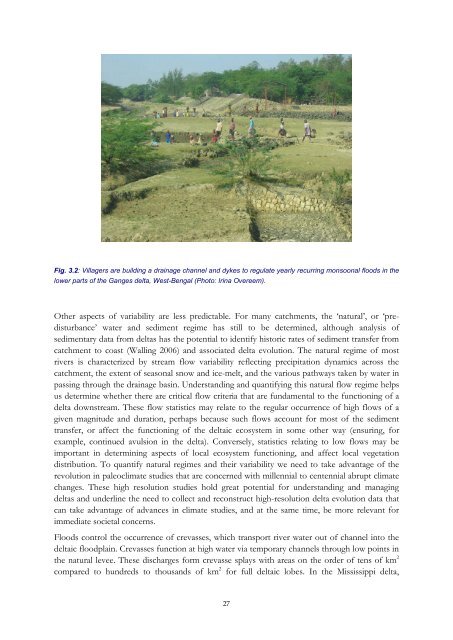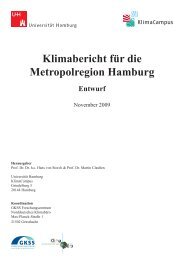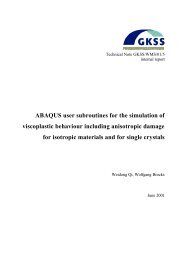Dynamics and Vulnerability of Delta Systems - loicz
Dynamics and Vulnerability of Delta Systems - loicz
Dynamics and Vulnerability of Delta Systems - loicz
Create successful ePaper yourself
Turn your PDF publications into a flip-book with our unique Google optimized e-Paper software.
Fig. 3.2: Villagers are building a drainage channel <strong>and</strong> dykes to regulate yearly recurring monsoonal floods in the<br />
lower parts <strong>of</strong> the Ganges delta, West-Bengal (Photo: Irina Overeem).<br />
Other aspects <strong>of</strong> variability are less predictable. For many catchments, the ‘natural’, or ‘predisturbance’<br />
water <strong>and</strong> sediment regime has still to be determined, although analysis <strong>of</strong><br />
sedimentary data from deltas has the potential to identify historic rates <strong>of</strong> sediment transfer from<br />
catchment to coast (Walling 2006) <strong>and</strong> associated delta evolution. The natural regime <strong>of</strong> most<br />
rivers is characterized by stream flow variability reflecting precipitation dynamics across the<br />
catchment, the extent <strong>of</strong> seasonal snow <strong>and</strong> ice-melt, <strong>and</strong> the various pathways taken by water in<br />
passing through the drainage basin. Underst<strong>and</strong>ing <strong>and</strong> quantifying this natural flow regime helps<br />
us determine whether there are critical flow criteria that are fundamental to the functioning <strong>of</strong> a<br />
delta downstream. These flow statistics may relate to the regular occurrence <strong>of</strong> high flows <strong>of</strong> a<br />
given magnitude <strong>and</strong> duration, perhaps because such flows account for most <strong>of</strong> the sediment<br />
transfer, or affect the functioning <strong>of</strong> the deltaic ecosystem in some other way (ensuring, for<br />
example, continued avulsion in the delta). Conversely, statistics relating to low flows may be<br />
important in determining aspects <strong>of</strong> local ecosystem functioning, <strong>and</strong> affect local vegetation<br />
distribution. To quantify natural regimes <strong>and</strong> their variability we need to take advantage <strong>of</strong> the<br />
revolution in paleoclimate studies that are concerned with millennial to centennial abrupt climate<br />
changes. These high resolution studies hold great potential for underst<strong>and</strong>ing <strong>and</strong> managing<br />
deltas <strong>and</strong> underline the need to collect <strong>and</strong> reconstruct high-resolution delta evolution data that<br />
can take advantage <strong>of</strong> advances in climate studies, <strong>and</strong> at the same time, be more relevant for<br />
immediate societal concerns.<br />
Floods control the occurrence <strong>of</strong> crevasses, which transport river water out <strong>of</strong> channel into the<br />
deltaic floodplain. Crevasses function at high water via temporary channels through low points in<br />
the natural levee. These discharges form crevasse splays with areas on the order <strong>of</strong> tens <strong>of</strong> km 2<br />
compared to hundreds to thous<strong>and</strong>s <strong>of</strong> km 2 for full deltaic lobes. In the Mississippi delta,<br />
27





